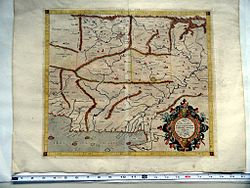Carmania (satrapy)
| Carmania Kirmān |
|||||
| Province of the Achaemenid, Seleucid, Arsacid, and Sasanian Empire | |||||
|
|||||
| Capital |
Karmana Shiragan |
||||
| Historical era | Antiquity | ||||
| • | Established | 6th century BC | |||
| • | Annexed by the Rashidun Caliphate | 650 AD | |||
Carmania (Greek: Καρμανία, Karmanía, Old Persian: Karmanâ,Middle Persian: Kirmān) is a historical region that approximately corresponds to the modern province of Kerman and was a province of the Achaemenid, Seleucid, Arsacid, and Sasanian Empire. The region bordered Persia in the west,Gedrosia in the south-east,Parthia in the north (later known as Abarshahr), and Aria to the north-east. Carmania was considered part of Ariana.
In the Early Bronze Age, late third millennium BC, it is postulated that a civilisation known as Jiroft civilisation developed and flourished in the region of Carmania. However, little is known of the history of the region during the Late Bronze Age and Early Iron Age. The region was settled by Iranian tribes in the first half of the first millennium BC.
Carmania was conquered by Cyrus the Great, founder of the Achaemenid Empire, in the 6th century BC. The 3rd century BC Babylonian writer Berossus detailed that Cyrus the Great granted Nabonidus, the last King of Babylon, Carmania as a vassal kingdom after the Achaemenid conquest of Babylonia in 539 BC. According to the 5th century BC Greek historian Ctesias, Cyrus, on his deathbed, appointed his son Bardiya as governor of the Bactrians, Chorasmians, Parthians, and Carmanians.Darius I later confiscated part of Nabonidus' land in Carmania. During the reign of Darius I, a royal road was built in Carmania, and the region was administered as a sub-province of the province of Persia. At a later date, Carmania came under the administration of a certain Karkiš, satrap (governor) of Gedrosia. It has been suggested that, due to an anachronism on behalf of Ctesias, Carmania may have become a separate province by the time of Artaxerxes II, in the late 5th century BC.
...
Wikipedia

